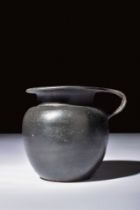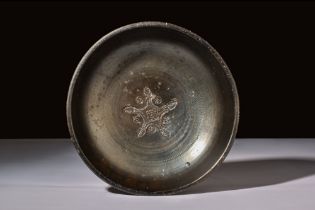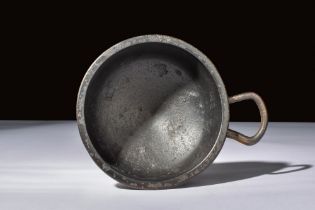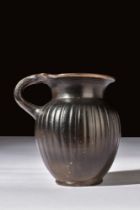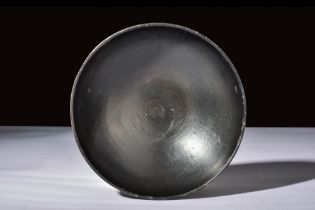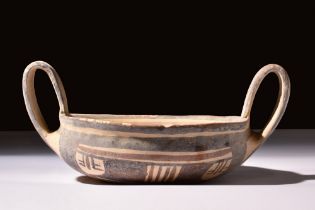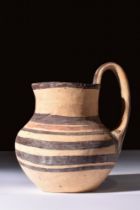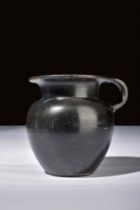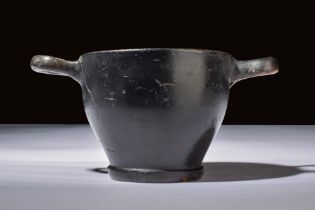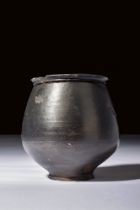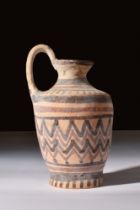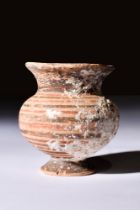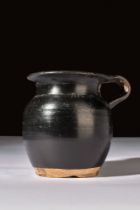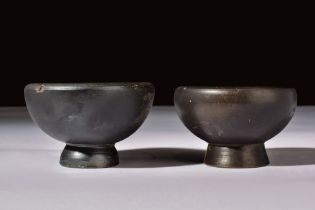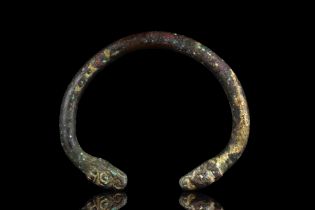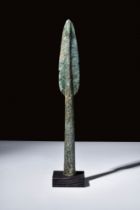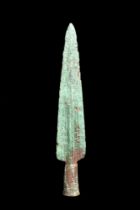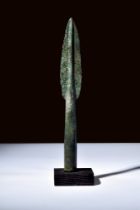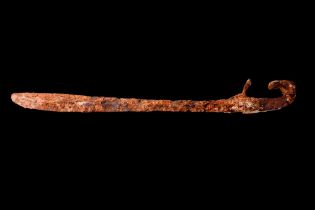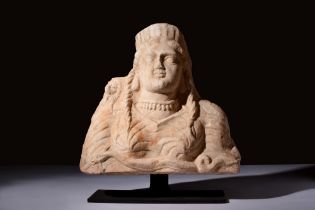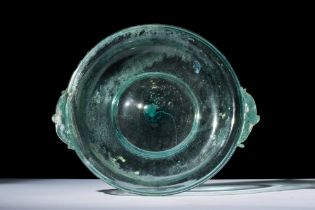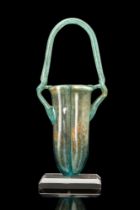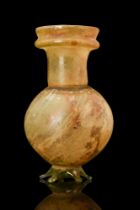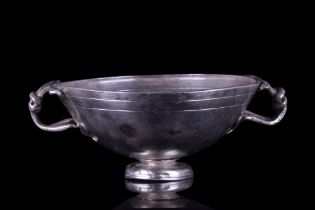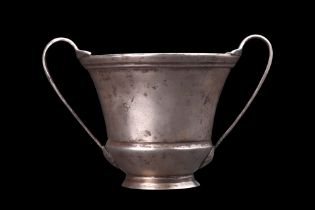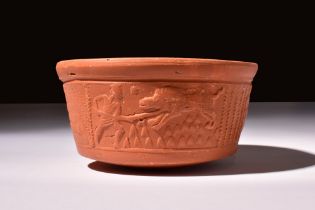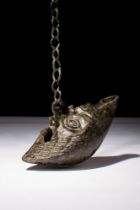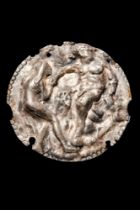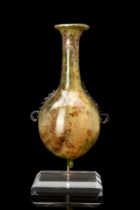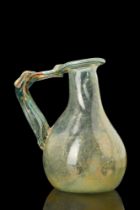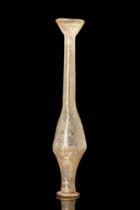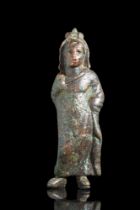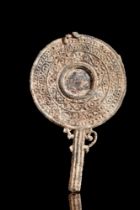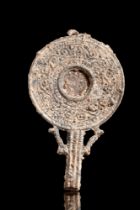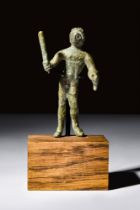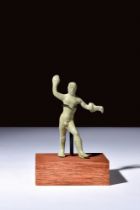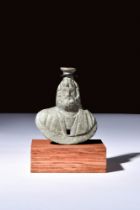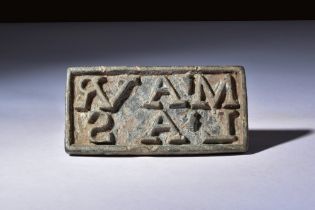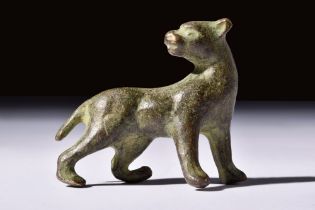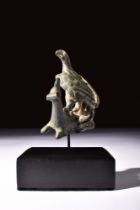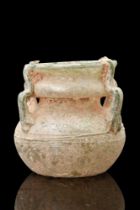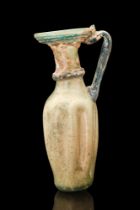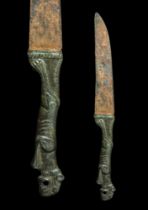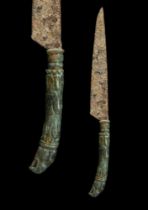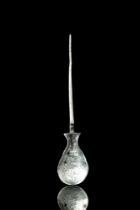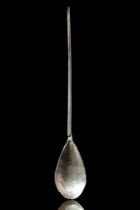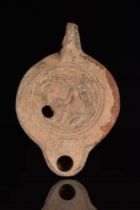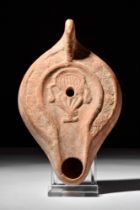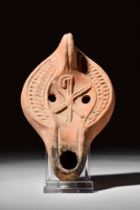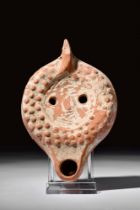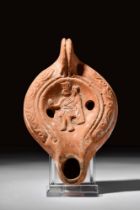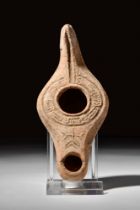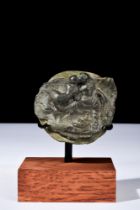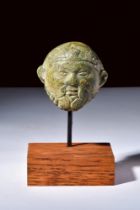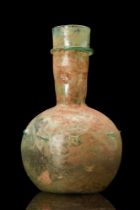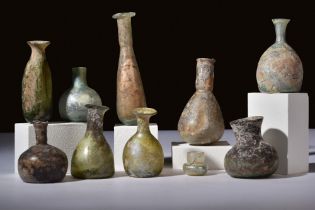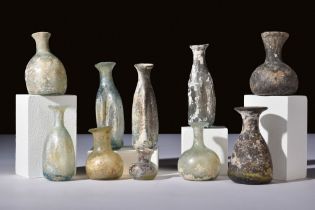Verfeinern Sie Ihre Suche
Schätzpreis
Kategorie
- Schmuck (89)
- Griechische, Römische, Ägyptische & andere Antiquitäten (84)
- Waffen, Rüstungen & Militaria (52)
- Skulpturen (42)
- China (34)
- Keramik, Fayencen (30)
- Glas & Kristall (29)
- Historische Baustoffe & Elemente (23)
- Großuhren (22)
- Bücher, Manuskripte & Schriften (18)
- Varia (14)
- Metalle (8)
- Islam (7)
- Präparate & Naturkundliches (6)
- Wissenschaftliche Instrumente (6)
- Vintage Fashion (5)
- Silber & Versilbertes (4)
- Ethnographie & Stammeskunst (3)
- Küchenutensilien (3)
- Münzen (3)
- Spielzeug, Modelle & Puppen (3)
- Sport Memorabilia & Equipment (3)
- Lampen (2)
- Oldtimer, Motorräder & Automobile (2)
- Porzellan (2)
- Textilien (2)
- Druckgrafiken & Multiples (1)
- Indien (1)
- Möbel (1)
- Werkzeug (1)
- Zeichnungen & Pastelle (1)
Künstler / Marke
Lostyp
- Ring (54)
- Bowl (22)
- Gold Ring (22)
- Anhänger (22)
- Figure (18)
- Intaglio (18)
- Schwert (18)
- Vessel (17)
- Halskette (16)
- Gold Pendant (15)
- Axe (14)
- Beads (12)
- Silver Ring (12)
- Round (10)
- Amulet (9)
- Band (9)
- Garnet (8)
- Scarab (8)
- Helme (7)
- Dagger (6)
- Flask (6)
- Plate (6)
- Speer (6)
- Bottle (5)
- Buddha (5)
- Bust (5)
- Becher (5)
- Figurine (5)
- Grenade (5)
- Jar (5)
- Krater (5)
- Ohrringe (4)
- Glass Bottle (4)
- Jug (4)
- Mask (4)
- Skyphos (4)
- Spearhead (4)
- Bracelet (3)
- Brooch (3)
- Chain (3)
- Chain Necklace (3)
- Messer (3)
- Lampe (3)
- Shabti (3)
- Terracotta Figure (3)
- Amphora (2)
- Armour (2)
- Beaker (2)
- Brooches (2)
- Button (2)
- Cameo (2)
- Kerzeleuchter (2)
- Gericht (2)
- Emerald (2)
- Flares (2)
- Gemstone (2)
- Glass Candlestick (2)
- Glassware (2)
- Kantharos (2)
- Kyathos (2)
- Paramerion� (2)
- Patera (2)
- Perlen (2)
- Perfume Bottle (2)
- Phiale (2)
- Scabbard (2)
- Ushabti (2)
- Vase (2)
- Adze (1)
- Blunt (1)
- Bridge (1)
- Carving (1)
- Chalice (1)
- Truhe (1)
- Cloisonne (1)
- Club (1)
- Säule (1)
- Corinthian Helmet (1)
- Cups (1)
- Tür (1)
- Falcata (1)
- Glass Jug (1)
- Glass Plate (1)
- Gold Bar (1)
- Knives (1)
- Brief (1)
- Lintel (1)
- Mace (1)
- Model (1)
- Becher (1)
- Noble (1)
- Öl Lampe (1)
- Olpe (1)
- Säule (1)
- Topf (1)
- Robe (1)
- Skulptur (1)
- Shawl (1)
- Shield (1)
- Shiva (1)
- Tisch (1)
- Tiles (1)
- Turquoise (1)
- Urne (1)
- Liste
- Galerie
Ein Abonnement der Preisliste ist notwendig um Ergebnisse, von Auktionen die vor einem längeren Zeitraum als 10 Tagen stattgefunden haben, ansehen zu können. Klicken Sie hier für mehr Informationen
Ca. 450 BC.A black glazed olpe, featuring a bulbous body, everted rim, and glossy black glaze. Size: L:90mm / W:95mm ; 147g Provenance: Property o...
Ca. 350 BC.A black glazed pottery footed bowl with an impressed central interior decoration consisting of four small human heads and a five armed ...
Ca. 400-300 BC.A black-glazed pottery cup, common in ancient Greek ceramics. The cup features a rounded body, loop handle, and lustrous black glaz...
Ca. 400-300 BC.A black glazed olpe featuring an elegant inverted pear-shaped body with incised vertical grooves. The vessel has a short cylindrica...
ATTIC BLACK-GLAZED DISH
Ca. 400-300 BC.An Attic glossy black-glazed deep dish with a curved rim. These vessels were used to present and contain various food items, rangin...
DAUNIAN BICHROME POTTERY KYLIX
Magna Graecia, Ca. 600-500 BC.A Daunian pottery kylix, featuring a wide bowl with two arched handles. It is adorned with bichrome decoration with ...
DAUNIAN BICHROME POTTERY JUG
Magna Graecia, Ca. 500-400 BC.A pottery jug with a short, flat base and a graceful, straight neck. It has a strap and an arched handle that goes f...
Ca. 450 BC.A black-glazed olpe with an inverted piriform body, short tubular neck, and loop handle, adorned with a rich black glaze. Size: L:85mm ...
ATTIC BLACK-GLAZED SKYPHOS
Ca. 350 BC.A black-glazed skyphos with deep, curved sides, two loop handles, and a smooth surface. The shape is characteristic of ancient Greek po...
APULIAN BLACK-GLAZED CUP
Ca. 350 BC.A black-glazed cup with a conical lower body, bulbous midsection, and everted rim. The glaze is enriched with iron oxide createing the ...
DAUNIAN PAINTED POTTERY OLPE
Ca. 600-500 BC.A pottery olpe with an elongated body, round mouth, and high arching single handle. The vessel is adorned with brown and reddish sl...
EASTERN GREEK POTTERY LYDION
Ca. 600-500 BC.A pottery lydion with an ovoid body on a tall flaring foot, the wide cylindrical neck and a flat disk rim. The vessel is painted wi...
Ca. 450 BC.A black-glazed olpe with a flat base, bulbous body, short neck, and everted rim. A singular handle has been applied from the neck to th...
CAMPANIAN PAIR OF FOOTED CUPS
Magna Graecia, Ca. 350 BC.A pair of two similar black-glazed pottery small cups, each standing on a low pedestal foot. Cups such as these were pos...
Ca. 800-400 BC.A bronze bracelet, composed of a circular, plain hoop, featuring decorated terminals, modelled as beast heads with large eyes and g...
Ca. 800-600 BC.A bronze spearhead with a leaf-shaped blade and a midrib extending into a hollow tubular shaft for attaching to a wooden pole. Spea...
Ca. 800-600 BC.A bronze spearhead with a leaf-shaped blade and a midrib extending into a hollow tubular shaft for attaching to a wooden pole. Spea...
Ca. 800-600 BC.A bronze spearhead with a leaf-shaped blade and a midrib extending into a hollow tubular shaft for attaching to a wooden pole. Spea...
A GREEK IRON FALCATA SWORD
Ca. 400 BC.A Greek iron falcata, comprised of a heavy single-edged blade widening towards the point. A handle with a curved pommel providing comfo...
ROMAN LIMESTONE FEMALE BUST
Eastern Mediterranean, Ca. 200-400 AD.A carved bust depicting a woman wearing draped garments and with her hair arranged in long braids. She is ad...
HUGE ROMAN GLASS PLATE
Ca. 50–300 AD.A stunning greenish-blue glass plate with an outward folded rim, hemispherical bowl, and applied ring foot. It features two dolphin-...
Ca. 100-200 AD.A double balsamarium made from blue-green glass. It consists of two joined tubular phials with flared rims and an applied handle th...
RARE ROMAN GLASS SPRINKLER FLASK
Ca. 100-300 AD.A Roman glass flask with a translucent olive colour. The vessel has a rounded body and tubular neck that expands into a hollow, pro...
Ca. 200 AD.A silver kylix with a hemispherical bowl, resting on a concave foot, with two equally spaced loop handles shaped as Hercules knots. The...
ROMAN SILVER SKYPHOS
Ca. 100 AD.An intricately crafted silver skyphos that features a flaring body with two elegant handles, each adorned with palmette finials. The ve...
Ca. 300 AD.A terra sigillata bowl with a reddish hue, tubular rim, and raised foot. The vessel depicts Hercules fighting the formidable Erymanthia...
ROMAN BRONZE OIL LAMP WITH CHAIN
Ca. 100 AD.A bronze oil lamp in the shape of a male head with a neat beard possibly Pan or Silenus. The face has large eyes and a large opening fo...
Ca. 100-300 AD. A silver phalera that depicts Hercules next to a nude woman. Phalerae were decorative discs that augmented a soldier's armor and w...
Ca. 300-400 AD.A greenish-yellow glass flask with an elegant pear-shaped body, adorned with two crimped strands of glass and loops. The long, slen...
ROMAN GLASS HANDLED BOTTLE
Ca. 100-300 AD.A blue-green blown glass bottle with a handle. The vessel has a flat bottom and pear-shaped body which tapers into a slender neck a...
ROMAN TALL FUSIFORM GLASS BOTTLE
Imperial period, Ca. 200-300 AD.A light-yellow glass vessel. The glass has an small lip and an everted rim leading to a long cylindrical neck whic...
Ca. 100-300 AD.A small bronze figurine depicting Serapis, a deity from Hellenistic Egypt that combines attributes of Greek and Egyptian divinities...
Ca. 100-300 AD.A lead votive mirror with a round frame, circular decorations around the central mirror area, and a rectangular handle with scroll-...
Ca. 100-300 AD.A lead votive mirror with a round frame, circular decorations around the central mirror area, and a rectangular handle with scroll-...
Ca. 500-300 BC.An Etruscan bronze figurine of Hercules, holding his characteristic club.This figurine captures his strength and poise of the hero,...
Ca. 500-300 BC.An Etruscan bronze Hercules figurine. Hercules, known to the Etruscans as "Herklus," stands in a contropossto pose, with his weight...
ROMAN BRONZE BUST OF SERAPIS
Ca. 100-200 AD.A bronze bust of Serapis, a syncretic deity originating from Hellenistic Egypt. The diminutive face has a prominent, rectangular no...
ROMAN BRONZE BREAD STAMP
Ca. 100-300 AD.An inscribed rectangular bronze stamp seal with a loop handle at the back. In ancient Rome, these stamps were used to imprint desig...
ROMAN BRONZE PANTHER FIGURINE
Ca. 100 AD.A striking bronze panther figurine. The animal stands poised, its head turned elegantly to the right, with a sleek, muscular body and s...
ETRUSCAN BRONZE KOUROS
Ca. 500 BC.A slender bronze Kouros figure of Etruscan origin. The figure stands with a subtle bend in the left leg and his hands gracefully by his...
Ca. 200-300 AD.A bronze fitting shows an eagle gripping a deer. The eagle's feathers and claws are detailed, and its head faces left. Size: L:50mm...
ROMAN LEAD PLAQUE WITH HERCULES
Ca. 100-200 AD.A rectangular form flat-sectioned plaque that displays a relief portrayal of Hercules in a frontal stance, firmly gripping his club...
ROMAN GLASS VESSEL WITH HANDLES
Ca. 300-400 AD.A glass jar with a pontil mark and a bulbous body that tapers into a thick neck. The rim consists of a hollow rectangular rib, from...
ROMAN GLASS DOUBLE BALSAMARIUM
Ca. 100-200 AD.A double balsamarium with two conjoined tubular phials and delicate glass thread on the exterior. The handles are applied on the bo...
ROMAN GLASS JUG WITH HANDLE
Ca. 200-300 AD.A glass jug with vertical tooled indents. The vessel has a flaring mouth and funnel-shaped neck that expands into a tall, rounded b...
Ca. 100-200 AD.An iron knife with a pointed, single-edged blade. The handle is made of bronze and resembles an elongated lion, leaping forward wit...
Ca. 100-200 AD.A sharp iron knife with a single-edged blade. The handle resembles an elongated eagle with detailed feathers and an open beak, symb...
ROMAN SILVER SPOON
Ca. 100-300 AD.A silver spoon featuring an elegantly curved bowl with markings inside, flaring out at the base to attach to a balanced, tapering h...
ROMAN SILVER SPOON
Ca. 100 AD.A silver spoon with a tear-shaped bowl and gracefully curved handle. In ancient Roman dining, such spoons combined form and function, a...
Ca. 300 AD.A terracotta oil lamp of Loeschcke type VIII. It has a circular handle and a workshop mark on the bottom. It also features a recessed d...
Ca. 400-500 AD.A mouldmade redware oil lamp, an example of the Hayes II A type. The lamp features a small krater in a recessed tondo, a lug handle...
Ca. 400-500 AD.A pottery oil lamp with a round body, spout for a wick, and a CHI-RHO monogram in the central tondo. There is a punched pattern on ...
ROMAN TERRACOTTA OIL LAMP
Ca. 200-300 AD.A pottery oil lamp with a rounded body, flat bottom, spout, and vent holes in the sunken discus. The lamp has raised dotted decorat...
ROMAN TERRACOTTA OIL LAMP
Ca. 200-300 AD.A terracotta oil lamp with a rounded body and a central relief that extends forward to form a short spout with a wick hole. The rel...
Ca. 400-600 AD.A pear-shaped pottery oil lamp with a central oil pouring hole and a rounded spout for a wick. It features a sculpted lug handle at...
Ca. 100-300 AD.A round bronze plaque that depicts a detailed, erotic scene of a seated man and woman sharing a kiss. Both lie on a couch, draped f...
ROMAN BRONZE HEAD OF SILENUS
Ca. 100 AD.A bronze head of Silenus, a mythological satyr associated with the theatre and revelry. The face is rather comic, featuring a large, cu...
Ca. 100-200 AD.A light blue-green glass bottle with a bulbous body, featuring crimped decoration around the middle. The vessel has a tapered neck ...
Ca. 100-300 AD.A set of 10 distinctly shaped glass vessels used to store perfumed oil, or unguents. The shapes in this lot vary, and include vesse...
Ca. 100-300 AD.A set of 10 distinctly shaped glass vessels used to store perfumed oil, or unguents. The shapes in this lot vary, and include vesse...

